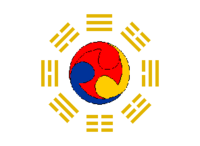East Asian Federation

| |
| Official Languages | Japanese, Corean, Marshallese |
| Capital | Quiòto |
| Government Type | Federation |
| Executive Council | Regent Maco, Princess Masaxi of Japan (President), King Amata of Ralik-Ratak, Viceroy ??? of the Micronesian Confederation, Supreme Chief ?? of Banaba |
| Prime Minister | ? |
| Establishment | 1912 |
| Revival | 2005 |
| Members | Empire of Japan, Micronesian Confederation, United Kingdom of the Ralik and Ratak Islands, Banaba |
The East Asian Federation, Tò-A-Rempò (東亜連邦) in Japanese, Toñ-A-Rienbañ in Corean (TAR for short), was created in 1912 between the nations of Corea, Japan and Lùquiù. It was effectively discontinued in 1920, when China invaded Corea and Lùquiù. However, the Federation was never officially dissolved. However, between 1920 and 2005, the Empire of Japan was the sole remaining member.
The TAR was created to encourage economic and cultural growth in East Asia, and to protect the nations of East Asia from European imperialism. The language of business was Japanese, but treaties and laws passed by the TAR would be translated into the member nations' languages. The TAR's executive authority was embodied in a council of the heads-of-state of the member nations (i.e., the Kings of Corea and Lùquiù and the Emperor of Japan), with the Emperor of Japan presiding (in the event of an underage head-of-state, the Regent for that state would take their place on the Council). The legislative authority was embodied in a High Parliament, with members elected by the legislature of each member, proportional to the population thereof. The TAR was a genuine attempt at co-prosperity and peace, unlike *here*'s Greater East Asian Co-Prosperity Sphere, which was merely a propogandistic name for Japanese exploitation. It had been hoped that the TAR would spread to Southeast Asia. The TAR was somewhat ideologically biased towards Japan, but it would be a mistake to think it was simply a Greater Japanese Empire.
The Federation was revived in early Gacudai 2 (2005) when negotiations between the United Kingdom of the Ralik and Ratak Islands and Japan resulted in the revitalization of the Federation.
The Federation is today primarily an economic union and a mutual-defense pact.
In late 2005 it was expanded to Nam Viet through the creation of the Asia-Pacific Trade Union. On 10 November 2007, Henua was granted observer status in the Federation.
A reformed Hunan in 2016 has reached out to the Federation for consideration as an observer, as well.